Definition: A matrix organizational structure is the arrangement of the personnel, i.e., the matrix leader, managers and employees, across the grid, such that a hybrid hierarchy is maintained. Here, there is a vertical and horizontal flow of direction and information, such that each subordinate has dual bosses. Out of these, one is the functional manager; and the other is the project manager.
Many substantial business organizations, especially the ones engaged in the engineering, architectural, construction, e-commerce and large-scale manufacturing businesses, prefer the matrix structure.
Also, the companies which have multiple product lines and the diversified business organizations feel more convenient in adopting this kind of structure.
Content: Matrix Organizational Structure
Matrix Organizational Structure Roles and Responsibilities
A hierarchy is followed in the matrix structure. Given below is the proper sequence of the flow of information, i.e., in the downward direction: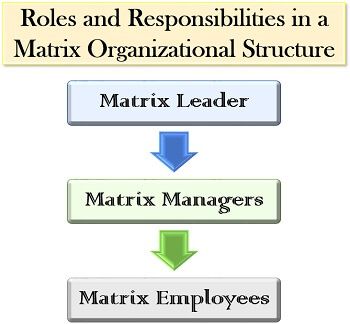
- Matrix Leader: The matrix is always lead by the company’s head or the CEO.
- Matrix Managers: This team of functional and project managers work under the CEO. They are responsible for the timely performance of the assigned task by the matrix employees.
- Matrix Employees: All the other people who report to the dual bosses (i.e., the functional and the project managers) and work under their guidance are termed as matrix employees.
Features of Matrix Organizational Structure
The principal trait of a matrix structure is its complexity. Therefore to simplify this concept, let us understand some of its other characteristics: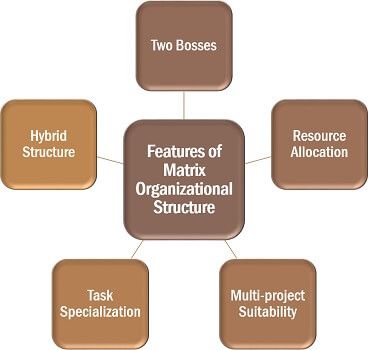
- Two Bosses: In a matrix organizational structure, the subordinates have to report to two superiors, one is the functional manager, and the other is the project manager.
- Resource Allocation: The aim of opting for a matrix structure is to ensure the highest possible utilization of human resource.
- Multi-project Suitability: When a company has limited personnel and various projects to handle at once, it can go for a matrix organizational structure to simplify the task.
- Task Specialization: When the managers concentrate more on their part of operations, they tend to specialize in particular areas. When the project manager takes care of the administrative functions, the functional manager looks after the technical elements.
- Hybrid Structure: It is the amalgamation of the two organizational structures, i.e., the functional and the project.
Matrix Structure Example
Let us take the illustration of an electronics manufacturing company, which is presently working on four different projects, each having its project manager (who are the senior engineers in the team).
However, the company has a single team of functional managers to look after the operations. The organization has a matrix structure to handle all the projects effectively.
Therefore, each executive works under his/her respective project manager, along with the functional manager.
Here, we have the company’s CEO as the ‘matrix leader’. Functional and project managers can be collectively known as matrix managers. Also, the various executives working under these managers are termed as matrix employees.
Matrix Organizational Structure Diagram
The given diagram will help us to figure out the structural design of the matrix organization mentioned-above: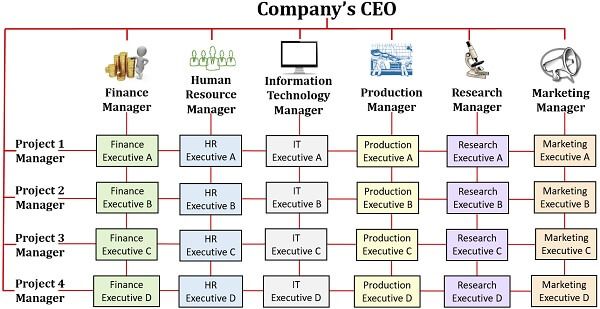
Types of Matrix Structure
The matrix structure is highly flexible and can be modified according to organizational needs.
It can be classified in terms of the distribution of power and authority, into three different types: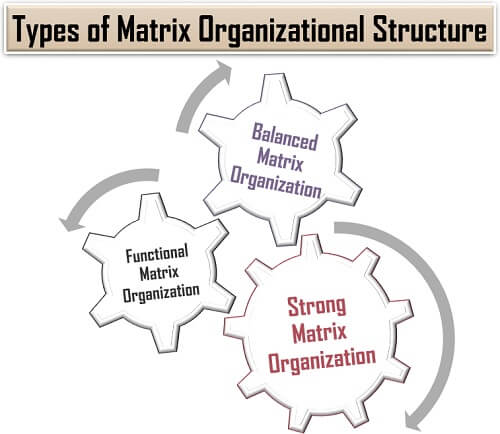
Functional or Weak Matrix Organization
As we call it, a functional structure, the functional manager exercises the maximum control over the budget, personnel and other resources of the projects.
Thus, limiting the responsibilities of the project manager to the coordination and administration of the team.
For instance; the production companies or dealership firms usually have a weak matrix organizational structure.
Balanced Matrix Organization
In this type of structure, proper coordination exists between the functional manager and the project manager.
The authority and power are evenly allocated to both of them. Both of them equally participates in the decisions associated with the allocation of the budget and additional resources.
Strong Matrix Organization
In a strong matrix organization, the project manager holds the supreme authority of decision-making in terms of the budget and other resources of the particular project.
However, the functional manager does not much control over the project-related decisions.
For instance; this type of structure is mostly prevalent in the architecture or construction companies.
Advantages of Matrix Organizational Structure
The matrix structure is widely used in the organizations which are large and diversify into different product lines.
Following are some of the pros of adopting such an organizational structure: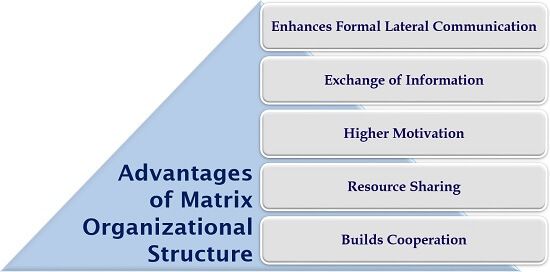
- Enhances Formal Lateral Communication: The matrix structure promotes progressive interaction among the individuals at the same corporate level.
- Exchange of Information: A vertical and horizontal interaction provides for a streamlined flow of the constructive ideas in the organization.
- Higher Motivation: It also boosts the morale of the employees as they are free to share their ideas and knowledge.
- Resource Sharing: It ensures efficient human resource management by adequately allocating managerial responsibilities.
- Builds Cooperation: The interpersonal relations improve when there is a matrix form of communication in the organization. Thus, employees also learn to cooperate.
Disadvantages of Matrix Organizational Structure
Though popular, but many critics believe that matrix structure usually harms the organizations.
Let us discuss the various cons in this context: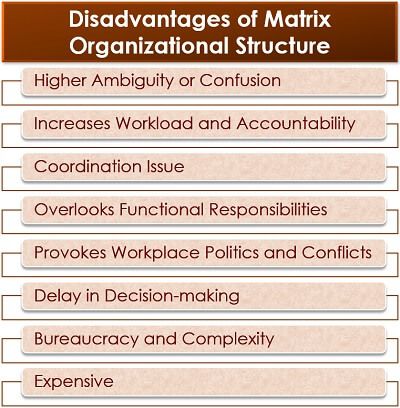
Higher Ambiguity or Confusion: The team members may not be apparent on whom to report, whose orders to follow, and who will provide them guidance.
Increases Workload and Accountability: When the managers are overburdened with responsibilities, the employees have to bear with a higher amount of accountability, i.e., being answerable to both the managers.
Coordination Issue: The conflicts and misunderstanding between the functional manager and the project manager can result in their poor coordination.
Overlooks Functional Responsibilities: In most of the matrix organizations, the project manager overtakes the charge of handling the team, thus underestimating the functional roles or responsibilities of the employees.
Provokes Workplace Politics and Conflicts: In a matrix structure, as we know that there are two bosses. If anyone of them turns out to be dominant, there will be a negative work environment full of conflicts.
Delay in Decision-making: When there are two managers involved in decision-making, it is undeniable that they may not agree on each others opinion, delaying the decision-making process.
Bureaucracy and Complexity: It is a complicated network where each employee needs to report and follow the orders of two bosses.
Expensive: The organization has to employ more managers than required, ultimately increasing the managerial salary overheads.
Best Practice
If an organization incorporates a matrix structure, it must well plan thing to avoid any loopholes and maintain the efficiency of the business operations.
Some the ways to improve the adaptability of this structure, are as follows:
The employees should be made aware of the organization’s vision, mission and the purpose of adopting a matrix structure.
The CEO should ensure that there exist a complete harmony and coordination between the functional managers and the project managers to avoid any conflicts and delay in decision-making.
In addition to this, there must be a robust conflict management system in the organization. It will avoid any loss due to inter-managerial disagreements.
Also, the employees should be given proper orientation, along with clearly defining their roles. The employees should be introduced to their respective seniors, along with specifying their responsibilities and accountability.
Vipika Kotangale says
Thank you for the information. That helped me